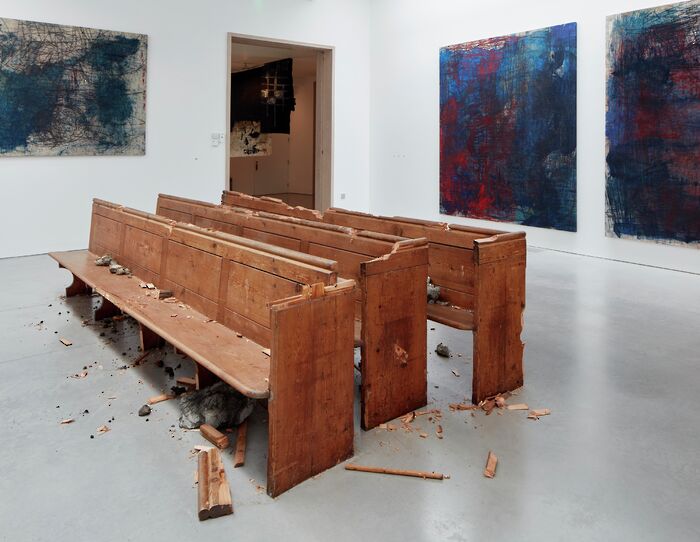Beggarstaffs: Exhibition Review
Moses May-Hobbs evaluates the curatorial effect of the most recent exhibition at the Fitzwilliam Museum, Beggarstaffs: William Nicholson & James Pryde
When asked whether we think an exhibition is good, our first is usually to remark upon one or some works of art that we liked best (‘Yes, the Beggarstaffs’ Don Quixote is exquisitely haunting’). Perhaps – should it stand out – we might offer a comment on the exhibition’s design, say an impressive space or building, some tasteful or creative decoration. What rarely springs to mind is the intangible and omnipresent installation that lies at the heart of a truly commendable exhibition: good curation. While good curation might be said to perform a conciliatory role, it is the vital mediator between the two impulses surging forth to fill the exhibition space, the archival and the stylistic. Where such mediation fails, or appears to be outrightly absent, the exhibition can be overwhelmed by one or the other impulse. What afflicts the Fitzwilliam Museum’s Beggarstaffs exhibition, however, is that the show’s rooms and works have been divided between these impulses as if by the toss of a coin, highlighting the excesses of both.
Good curation might be said to perform a conciliatory role
At a hundred and thirty five works, the exhibition is considerable, and from first glance there is a sense that the museum’s relatively small temporary exhibition space is being overwhelmed. Information is the tyrant of this first room; three walls are packed with a mass of prints, early works, and jarringly grey wall-texts that variously provide both biography and interpretative commentary. The collection amassed is certainly impressive in size, and items like William Nicholson’s woodblocks are enticing manufactural insights, but the multiple copies of Nicholson’s books shown and the tightly spaced clusters of his larger prints combined with roaming wall-texts give the impression that no curatorial restraint had moderated the display.
Extensive and haphasardly positioned wall-texts – a phenomenon which Andrew Graham-Dixon compares to ‘attending a performance of one of Beethoven’s late string quartets while being simultaneously subjected to the sound of piped muzak’ – clutter around all but a few of the exhibition’s works. The Fitzwilliam might benefit from a glance towards Kettle’s Yard and its approach towards the use, or lack thereof, of wall-texts, a decision which encourages a less distracted encounter with the art itself, which can then be augmented at will with information in a separate exhibition guide.
Towering inky canvases surround the visitor and seethe with organic decay against black walls
The conceptual basis of the exhibition, the intersection between the art of William Nicholson and James Pryde in the minimalist posters of the Beggarstaff brothers, is banished to the back of this first room. Passing visitors disrupt the view of these striking posters, which are most deserving of better attention. Yet while only Cinderella and Don Quixote are lent the space and emphasis that these stylistically radical, even transgressive, posters deserve, the exhibition outstays its welcome in dedicating an entire room to both artists’ later works.
These works – however cluttered and unselective in display – are at least lit with the soft glow and pale walls necessary for the display and preservation of prints. The dark series of rooms which house Nicholson and Pryde’s oil paintings suffer from quite the opposite; there is a pursuit of theatricality which ignores the archival function of a museum.
Pryde’s The Human Comedy series occupies a macabre end room. Towering inky canvases surround the visitor and seethe with organic decay against black walls. Eerier still is one painting, The Death of the Great Bed, which remained unfinished and unvarnished at the time of Pryde’s death. And yet, this carefully balanced, well-spaced display suffers from the exhibition’s most tragic pitfall: the dramatization of lighting in spite of – not in aid of – the viewing experience of these distinguished but dark canvases. In this respect, the exhibition is exemplary of a sadly routine error in the art world. Placing acute down-lighting above canvases; worse, above those dark, and worst of all above those unvarnished; renders the top of the canvas effectively invisibly, and discourages the viewer seeking a closer look.
Though the National Gallery’s quite recent change to gentler, less acute lighting marks a positive shift, the widespread misuse and abuse of lighting in exhibitions and permanent collections serves to highlight the obvious but often forgotten role of the curator. The archivist is happy that every work acquired is present and well-labelled. The exhibition designer desires a memorable, dramatic visual impact. Both these aims are laudable, but neither one ought to overpower the other. When captivating works and intriguing stories fail to capture us however, it is more often than we realise the result of a failure in the curation of the exhibition, of failing to find the perfect balance.
 News / Caius mourns its tree-mendous loss23 December 2025
News / Caius mourns its tree-mendous loss23 December 2025 Comment / Yes, I’m brown – but I have more important things to say22 December 2025
Comment / Yes, I’m brown – but I have more important things to say22 December 2025 News / Clare Hall spent over £500k opposing busway 24 December 2025
News / Clare Hall spent over £500k opposing busway 24 December 2025 Interviews / Politics, your own way: Tilly Middlehurst on speaking out21 December 2025
Interviews / Politics, your own way: Tilly Middlehurst on speaking out21 December 2025 News / King appoints Peterhouse chaplain to Westminster Abbey22 December 2025
News / King appoints Peterhouse chaplain to Westminster Abbey22 December 2025









